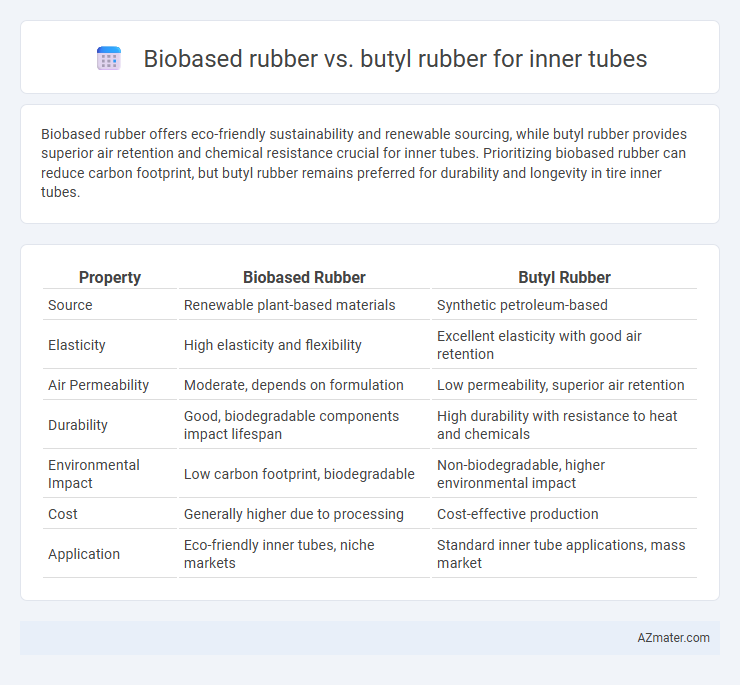Biobased rubber offers eco-friendly sustainability and renewable sourcing, while butyl rubber provides superior air retention and chemical resistance crucial for inner tubes. Prioritizing biobased rubber can reduce carbon footprint, but butyl rubber remains preferred for durability and longevity in tire inner tubes.
Table of Comparison
| Property | Biobased Rubber | Butyl Rubber |
|---|---|---|
| Source | Renewable plant-based materials | Synthetic petroleum-based |
| Elasticity | High elasticity and flexibility | Excellent elasticity with good air retention |
| Air Permeability | Moderate, depends on formulation | Low permeability, superior air retention |
| Durability | Good, biodegradable components impact lifespan | High durability with resistance to heat and chemicals |
| Environmental Impact | Low carbon footprint, biodegradable | Non-biodegradable, higher environmental impact |
| Cost | Generally higher due to processing | Cost-effective production |
| Application | Eco-friendly inner tubes, niche markets | Standard inner tube applications, mass market |
Introduction to Inner Tube Materials
Inner tubes in tires traditionally use butyl rubber due to its excellent air retention and chemical resistance properties. Biobased rubber, derived from renewable plant sources like guayule or dandelions, offers a sustainable alternative with comparable elasticity and durability. Advances in biobased rubber technology aim to reduce environmental impact while maintaining the performance standards required for inner tube applications.
Overview of Biobased Rubber
Biobased rubber, derived from renewable natural resources such as guayule, dandelion, or Hevea brasiliensis, offers an environmentally sustainable alternative to synthetic butyl rubber commonly used in inner tubes. This type of rubber provides comparable elasticity, tensile strength, and gas impermeability essential for inner tube performance while reducing reliance on fossil fuels and lowering carbon emissions. Advances in biobased rubber technology improve durability and resistance to heat and aging, making it a viable, eco-friendly option for the tire industry.
Properties of Butyl Rubber
Butyl rubber excels in inner tube applications due to its exceptional air impermeability, chemical resistance, and durability under extreme temperatures. Its low gas permeability significantly reduces air loss, making it ideal for maintaining tire pressure over extended periods. The material's resilience to ozone, weathering, and flexing ensures long-lasting performance and safety compared to biobased rubber alternatives.
Environmental Impact Comparison
Biobased rubber for inner tubes significantly reduces carbon footprint by utilizing renewable plant-derived materials, leading to lower greenhouse gas emissions compared to petroleum-based butyl rubber. While butyl rubber offers excellent air retention and durability, its production relies heavily on non-renewable resources and generates more environmental pollutants during manufacturing. Choosing biobased rubber supports sustainability goals by minimizing reliance on fossil fuels and enhancing biodegradability in end-of-life disposal.
Performance and Durability Analysis
Biobased rubber offers enhanced sustainability with comparable elasticity and resilience, while Butyl rubber excels in gas impermeability and resistance to heat aging, making it a preferred choice for inner tubes requiring long-term air retention. Performance tests show Butyl rubber exhibits superior puncture resistance and lower air permeability, contributing to enhanced durability and safety in high-pressure applications. Biobased rubber demonstrates promising mechanical strength but currently faces limitations in consistent durability under extreme temperature and pressure conditions compared to Butyl rubber.
Cost Considerations and Market Availability
Biobased rubber for inner tubes typically offers a more sustainable option but often comes at a higher initial cost due to limited production scale and raw material sourcing complexities. Butyl rubber remains more cost-effective and widely available, benefiting from established manufacturing processes and a mature supply chain that supports large-scale demand. Market availability for biobased rubber is growing but still lags behind the extensive distribution network and consistent pricing of butyl rubber.
Air Retention Capabilities
Biobased rubber exhibits comparable air retention capabilities to butyl rubber, primarily due to its dense polymer matrix that minimizes gas permeability. Butyl rubber remains the industry standard for inner tube applications because of its superior impermeability and long-term air retention, attributed to its unique isobutylene structure. Advances in biobased rubber formulation are narrowing the performance gap by enhancing cross-link density and incorporating natural fillers to improve barrier properties.
Compatibility with Various Tire Types
Biobased rubber exhibits enhanced compatibility with a wide range of tire types, including radial, bias-ply, and tubeless designs, due to its natural elasticity and chemical adaptability. Butyl rubber excels in air retention and impermeability but may require specific formulations to match the flexibility needed in certain high-performance or off-road tire variants. Compatibility with various tire types is crucial for inner tubes, making biobased rubber a sustainable alternative without compromising durability or performance.
Future Trends in Inner Tube Materials
Biobased rubber is gaining traction as a sustainable alternative to traditional butyl rubber for inner tubes, driven by increasing environmental regulations and consumer demand for eco-friendly materials. Innovations in biopolymer extraction and compounding technologies enhance the performance and durability of biobased rubber, narrowing the gap with butyl rubber's superior air retention and chemical resistance. Future trends indicate a hybrid approach combining biobased materials with synthetic butyl to optimize cost, environmental impact, and mechanical properties for inner tube manufacturing.
Conclusion: Choosing the Right Inner Tube Rubber
Biobased rubber offers sustainable advantages with biodegradability and reduced environmental impact, making it ideal for eco-conscious inner tube applications. Butyl rubber provides superior air retention, chemical resistance, and durability, ensuring longer lifespan and optimal performance in harsh conditions. Selecting the right inner tube rubber depends on balancing environmental priorities with performance requirements, where biobased rubber suits green product lines and butyl rubber meets high durability demands.

Infographic: Biobased rubber vs Butyl rubber for Inner tube
 azmater.com
azmater.com